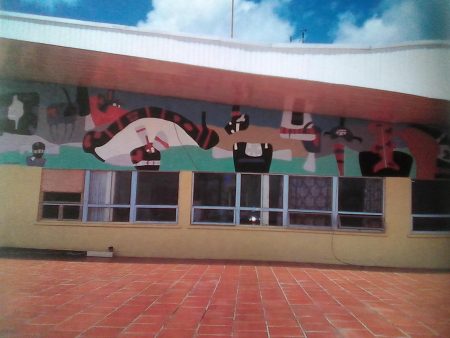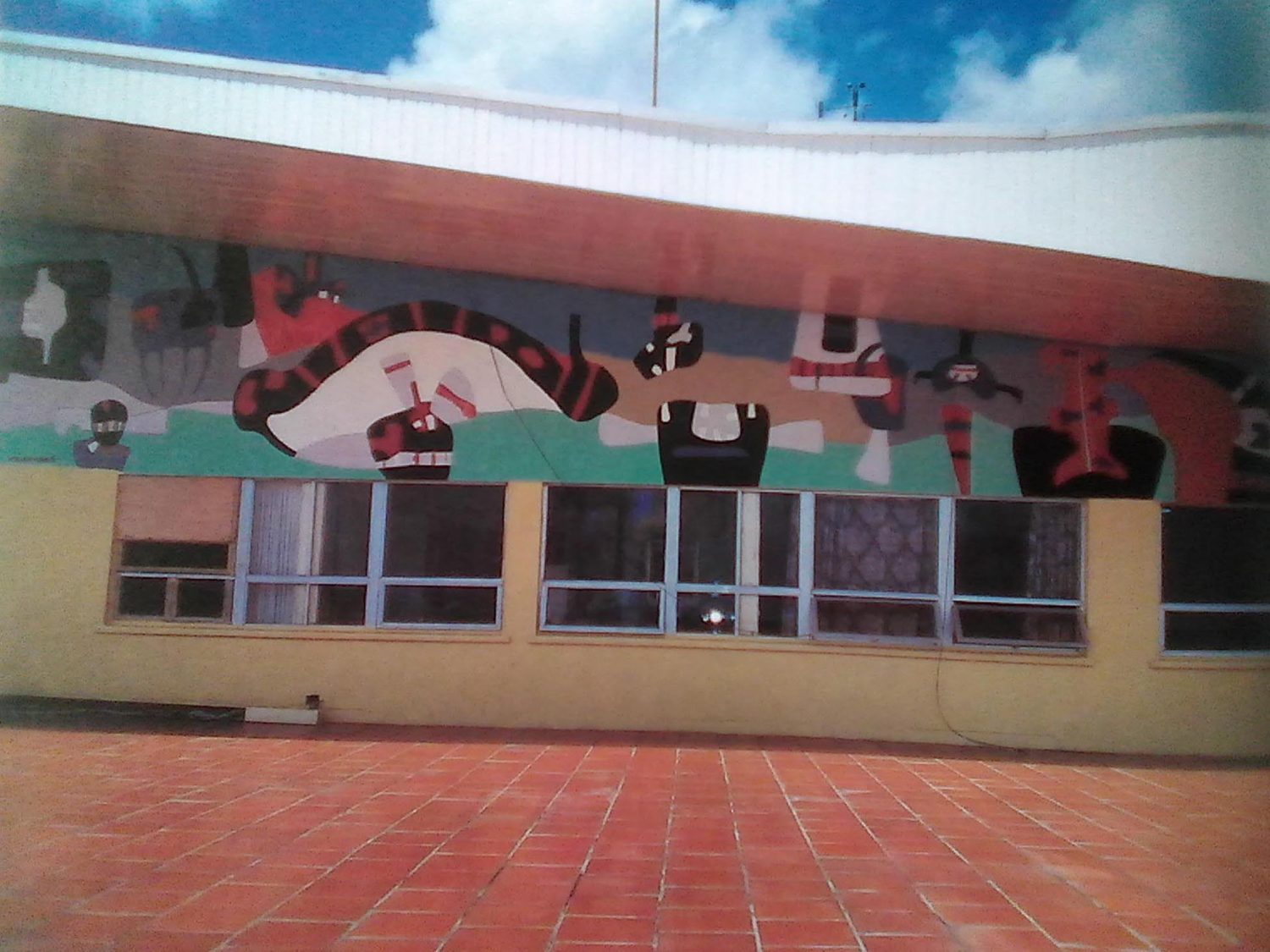Dear Editor,
Please allow me to offer some comments and corrections to your editorial of July 5th last, which followed on your reports last April on the most recently imperilled Aubrey Williams murals at the Cheddi Jagan International Airport. I note in passing that this appeared a day after I had received a phone call from one of your feature writers, who solicited my opinion as to the status of the two murals that had suffered a more perilous fate, reported on in 2007, and whether any possibility existed of their restoration to public view.

Photo credit: Fiona-Saffron Wilkes
From the catalogue of the exhibition Aubrey Williams,
Whitechapel Art Gallery, London, June-August 1998
Published by the Institute of International Visual Arts (inIVA)
in association with the Whitechapel Art Gallery
First of all you correctly say that there are five murals at the airport, but four of these five, not two, were originally conceived and executed by the artist on the outer walls: the first two indeed on the outer, west wall of the airport, being Itiribisi and Maridowa, the subject of recent reports; and the second two, also on outer, but south-facing walls, being Kamarang and Kaituma, whose fate your writer called to consult on, and which used to be seen by arriving passengers as they walked across the tarmac to enter the airport via the immigration area.
The fifth named, Tumatumari, is the one interior mural, referred to as “on (sic) the lounge” in the simple catalogue of Williams’ Carifesta 1972 exhibition in Georgetown. I remind readers, however, that this mural was also the near victim of destruction, circa the 1990s I believe, when once again the airport building was undergoing expansion. The frantic alarms raised at the time preserved the mural’s existence. Sometime later, the artist Philbert Gajadhar cleaned and restored this work, which departing passengers can still see on the back wall of the area where they line up to check their documents through Immigration.
I also noted particularly to your reporter that Mr Gajadhar had been a final year painting student at the Burrowes School of Art, a few months from graduation in 1986, when he had had the good fortune of being recommended by Dr Denis Williams, then the Director of Art and Anthropology in the Department of Culture, to assist Aubrey Williams when he returned to Guyana for a brief ten days, intent on restoring his 1970 murals. Mr Gajadhar later received UNESCO training in conservation, of some weeks or months duration I believe, through the Department of Culture.
Additionally I must correct my off the record comment, referenced in passing in your editorial, about leaks from the area of the south-facing murals to the ground floor below; this emanated not from the roof, but from an area of the patio, which problem was finally solved by the extended roof. In fact it was the support structures for this extended roof that were to practically wall in and obscure the murals from view.
The National Gallery, most regrettably, was not called in during this period (as we had been previously, to advise on protection of the art works before any construction had started). Even more regrettably, when the damage so to speak was already in place and could not in all practicality have been undone (involving the dismantling of a just built, extensive structure), I then received a call asking me to come up to Timehri to see the paintings.
I say this not in any way to point fingers or to recriminate at this stage of this story, but in part to answer SN’s rhetorical lament, at the end of its editorial: “When will we begin to appreciate the value of the arts and culture to our society?” And surely your editorial writer knows the painful depths and complexities to any answer to this question.
But my shorter answer here would be: when we start to appreciate the value of those national institutions established to promote and foster the desired appreciation of the arts and culture, and those who are put in positions of leadership and expected to build, from the ground up, those institutions.
Indeed I am well aware of my current situation, sharing with caution in this letter a few items of information that I was privy to only by virtue of my position as the Director and Curator of the National Gallery for seventeen years, a position which, despite an acknowledged work record of establishing high professional standards, often in challenged circumstances, in presenting a steady output of public exhibitions, other events and projects, seems to have earned me only the right to be referred to, for some time now, as the ‘then’ or the ‘former’ Curator, a subject about which, in fact, I can say no more in the public domain.
Indeed institutions like the National Gallery, Castellani House, have promoted both the practice and the appreciation of the arts, through a wide-ranging programme of events and projects, achieved only by relentless hard work, constancy of purpose and fidelity to the most numerous and smallest of details, requiring stamina and perseverance to meet these responsibilities over many years.
There should be no flippancy or cynicism therefore, let alone spite and vindictiveness, or petty one upmanship, surrounding such institutions or their issues. Art and culture is serious business.
It is not shiny frippery, to be put on quickly, like decoration, to impress, or tossed aside as quickly, when we are done with it, until the next time it is needed.
Institutions and their projects, in other words, need to be managed with courage, clarity of thinking, a serious grasp, by all concerned, of the challenges always ahead, and utter transparency and accountability. But it is only when dishonesty, hypocrisy and sycophancy do not rule the day, and wrongdoing is not indulged, accommodated and rewarded, whether in art and culture, or in any other area of national life; when instead there is at least honour and integrity of purpose and action, good faith and hard work, and no fear in defending the work being done ‒ not for narrow self-interest, but for the larger idea or cause, whether it be national institution, citizenry, or country ‒ only then can we talk about ‘[our] appreciation of the arts and culture’. Because only then shall there be in place an enhancement of our wider society and the way it functions, for the benefit and the quality of life of all the communities in our country, in all of their manifestations. The arts and culture cannot exist in a vacuum.
I wish to end with a recommendation, in returning to the subject of the Williams murals, and how we may avoid such future disasters.
There is urgent necessity for an inter-agency advisory panel, which should consist of representatives not only of the National Trust but also of the National Gallery, and representatives of the professional bodies of architects and engineers, with additional professionals from relevant agencies, NGOs or areas of the country depending on projects actively being considered.
There is in fact an important grey area where art, public monuments and public (access) structures overlap, and careful consideration needs to be undertaken to set up protocols and best practices which will actively monitor and ensure the continued existence of these special works of national patrimony.
So, again, what I ultimately propose is what I have always expected as the norm, that is, mutual respect and cooperation, enabled by informed opinion and action, for the good of Guyanese society, so that the arts and culture which is ours may survive and flourish.
Yours faithfully,
Elfrieda Bissember

